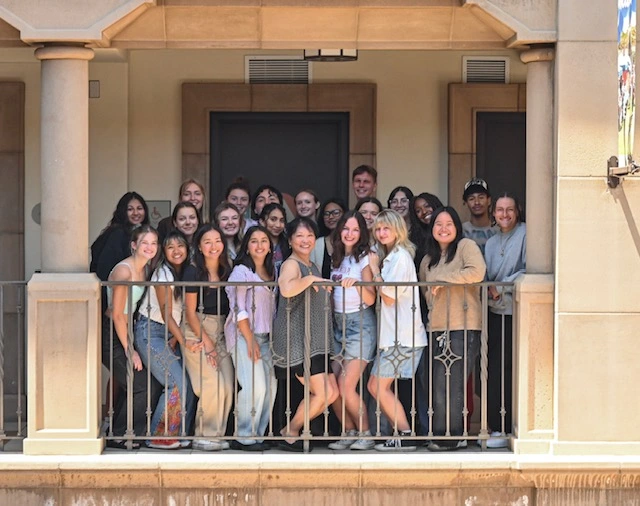Riti Dey / Assistant News Editor
During last week’s record-breaking storm, the City of San Diego experienced the most rainfall in its history in one day. According to CBS News, San Diego saw “an astonishing 2.73 inches (6.9 centimeters) of rain” on Monday Jan. 29, exceeding the typical amount of rainfall (about 5 inches) for the entire month of January in the city.
CBS reported that it was the “wettest day in January history.”
2023-2024 marks what is known by meteorologists as an El Niño year, a concept which is determined by warmer Pacific Ocean temperatures, influencing climate patterns around the world. In Southern California, The National Oceanic and Atmospheric Administration declared that “moderate to strong El Niño conditions during the fall and winter result in wetter-than-average conditions,” as can be seen in San Diego this year.
The San Diego Union-Tribune reported flooding on several roads, including Mission Boulevard at Reed Avenue, North Mission Bay freeway ramp at Interstate 5 and more. San Diego Mayor Todd Gloria issued evacuation warnings to residents in flood-prone areas such as Southcrest, Encanto and Mission Valley. KCRA News explained, “firefighters and lifeguards rescued about two dozen people from the rushing San Diego and Tijuana rivers… two homeless shelters were also evacuated.” The City of San Diego released storm preparedness statements, providing free sandbags at recreation centers to prevent or reduce flood water damage in homes.
The flooding did effected USD students, faculty, and staff, as not many San Diegans were equipped to handle such intense weather conditions. The floods affected several homes, including USD English professor Dr. Carlton Floyd.
“It has been daunting and discouraging,” Floyd shared. “Most of my neighbors were flooded here in Spring Valley, where I live, and one recalled that we have not seen anything like it in this area since the mid 1970s. A neighbor two doors down is having to move, her house flooded so badly. There are U Haul Big Boxes outside her place, as we speak.”
Floyd continued to explain how the flooding affected his home. “I am not in that shape. I can fix or remove most things that got wet, although it is expensive and work intensive… I think what’s most depressing is that few around here have flood insurance. I’m guessing that it will take another month or so before the house is back to generally sound conditions.”
USD junior Amelia Douglas reflected on the effects of the flooding on her residential area by Mission Beach.
“I was working as a Recruitment Counselor [for Panhellenic Recruitment] on campus, and [the rain] made me late for trainings because I couldn’t drive for some time or because I was trying to help friends sandbag their houses or deal with preventing water damages in the best ways we could,” Douglas said.
“I have been mostly worried about my car and being able to get to and from places, because when it rains the streets flood, and I am very south Mission so it makes it dangerous for me to get anywhere.”
The blustery storms peaked at 35 to 40 mile-per-hour winds, which were strong enough to bring down several trees and powerlines. CBS8 reported that a 70 foot tall pine tree fell on a house, wrecking the house as well as an SUV in North Park. Over 1,600 customers of San Diego Gas & Electric experienced a power outage, which reportedly lasted several hours in areas including Nestor, San Ysidro and Otay Mesa.
The USD Residential Life Department sent out “Rain Advisory” emails with suggestions on accommodations for such problems, such as keeping windows closed, dressing for the rain and reporting to USD Public Safety if any water leakage occurs in student housing.
The roof of a dorm in Manchester Village collapsed due to the rain, causing issues for some USD students. USD sophomore Aliya Garrett shared her experience living in Manchester Village amid the flooding, which affected both her and her roommate.
“We were both transfer students for the soccer team, so we drove down on Sunday with our car jammed packed to find out our dorm was no longer available because the day before, so much rain had come in that the roof had collapsed,” Garrett explained.
“That was very problematic because I was coming from out of state so I had a lot in my car and I really didn’t want to move twice, but I had to.”
Garrett’s troubles continued, despite being moved to a different dorm. “I think it was handled poorly,” Garrett said. “[USD Residential Life] put us in a temporary dorm after waiting five hours, and were not on top of the repairs. Then four days later, they told us to move in because it was fixed but failed to inform us that there were actually bed bugs. The repair is fixed but because of the bugs, we have been permanently removed and are waiting for them to treat our stuff. It will likely be at least another week before we get our things decontaminated and move in somewhere else.”
Floods, evacuations and power outages effected the USD community the week before spring semester started.
On the second week of the semester rain began again. On Sunday Feb. 4, an atmospheric river hit California, which caused heavy rain and storms across the state. Heavy rain began Monday in San Diego.
According to the National Oceanic and Atmospheric Administration “atmospheric rivers are relatively long, narrow regions in the atmosphere – like rivers in the sky – that transport most of the water vapor outside of the tropics.” Atmospheric rivers cause heavy rainfall like what San Diego has experienced this week.
According to Fox 5, San Diego, Fashion Valley, an area close to USD’s campus, received 1.58 inches of rain from Sunday to Tuesday morning.
Fox 5 says rain is expected to continue until the morning of Friday Feb. 8.
Record breaking rain and flooding hit San Diego the week before spring semester began. Photo courtesy of @usdcas/Instagram





Leave a comment